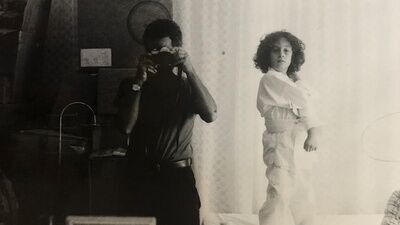The now-81 Nikzad Nodjoumi is an Iranian artist who moved to New York in the ‘60s, finding his revolutionary spirit in a time when it was everywhere in the Big Apple, only to watch the rise of the Shah in his home country. Of course, this political and social upheaval formed the Islamic Revolution, and Nodjoumi’s art boldly reflected the time in which he was radicalized, fearlessly taking aim at not just the leadership in his country but the systems around the world that propped it up. The art seen in “A Revolution on Canvas” is breathtaking in its concept and execution, a blend of pop art like Nodjoumi saw in the counter-culture movement of the ‘60s in New York and the images of his culture. A greater appreciation of Nodjoumi as an artist will surely emerge from this project.
However, what separates “A Revolution on Canvas” is the effort to better understand Nodjoumi as a man, warts and all. He is an open interview subject for his daughter, often answering her questions as he paints, furthering the merging of artist and father into one image. He is also clear about the problems that led to his divorce from Nahid Hagigat, Sarah’s mother and an artist in her own right. He left Hagigat and his daughter to join the revolution against the Shah, and that spirit impacted everything he did. When she asks if he missed her, he bluntly says, “No.” At one point, he seems startled at the suggestion that going to a protest on his wedding day would be an unusual decision. One senses an attempt on the filmmaker’s part to better understand this part of her father and how his passionate beliefs impacted his art and his family. Sara says, “So much of my memory comes from his paintings,” and that aspect of “A Revolution on Canvas” is the film’s most compelling.
Embedded in this fascinating family drama is something of an international thriller in the Nodzoumis’ attempts to retrieve some of Nikzad’s art from the Tehran Museum of Contemporary Art. When protests erupted in the city, Nodzoumi fled the country, leaving behind some fascinating paintings, work that he agrees may not be his best but are historically essential to capturing the tumultuous time in Iran in which they were made. The attempt to get the paintings out of the museum’s storage includes redacted names and blurred footage, people who don’t want the authorities to know that they’re trying to bring work deemed anti-Iranian back into the light. It’s well-done stuff that lands in an interesting place, but I was consistently more drawn in when watching Sara and Nicky discussing his life and work as he painted, still trying to express something through his art that he can’t in words. One imagines he will be forced by something inside to do so until his dying day.
Opens in New York today and Los Angeles on December 8th.

